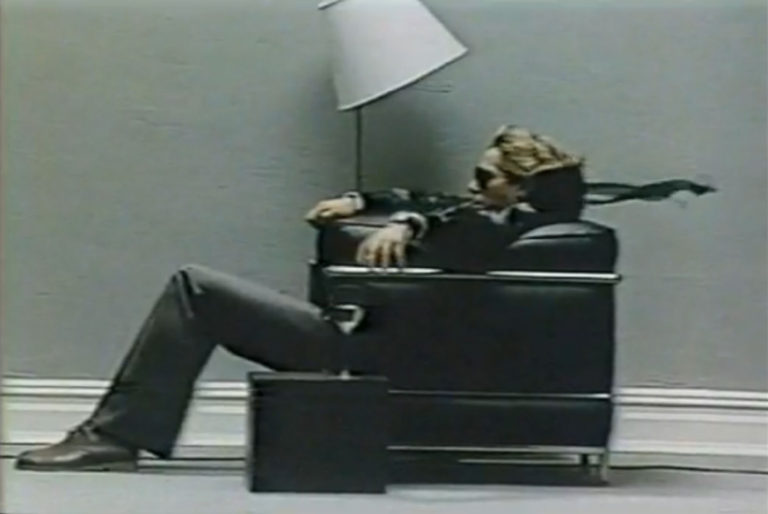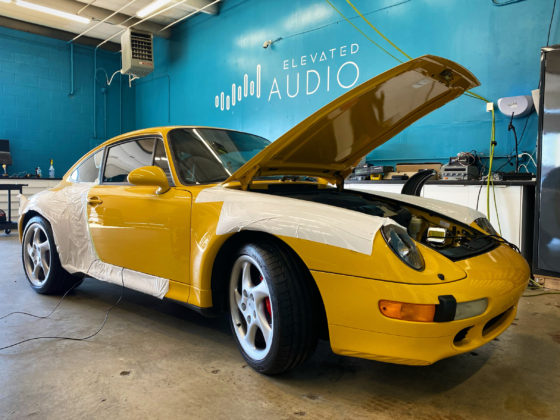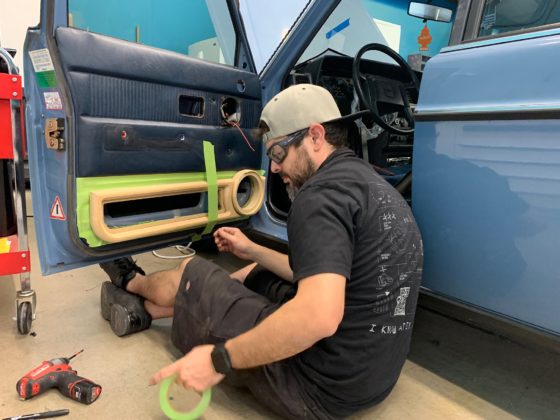A recent poll asked members of a popular car enthusiast group the following question – ” What ONE piece of stereo equipment could you add or upgrade in your vehicle to achieve the most noticeable difference in your quest of better audio?”
The results showed me that, as a leading shop in our industry, we have our work cut out for us in educating most customers that schedule an audio design consultation with us. There were four options to choose from: speakers, stereo, DSP, and amplifiers.
 The results:
The results:
42% of vote to Speakers
33% of vote to Stereo
17% of vote to DSP
8% of vote to Amplifiers
Now, while all of the choices above would play a role in effecting the audio quality, there is one that I believe makes the most noticeable difference hands down.
Here is my list in order of least importance to highest.
STEREO
Ah the car stereo, it is often the focal point of the audio system. Siblings and spouses have fought for control of this black box for ages. In fact, it is often the only component of your audio system that can be seen, touched, and adjusted. It’s not a surprise that most would believe this magic music box would have all the powers needed to ensure the proper reproduction of amazing audio.

The sad truth is that, beyond it’s flashing lights and pretty color screen, it is only just a tool for transferring your music from your cell phone via USB or Bluetooth and playing those relics we used to call compact discs. That’s OK with me! Your stereo is really not that important.
To some of you, this may come as a shock and to others, it may make perfect sense. Either way, it’s great news for you since most vehicle manufacturers are making it very difficult to replace the stereo in new vehicles. Your new Honda may have climate controls that display through the factory stereo screen or vehicle settings that would be lost if you were to replace the stereo with a fancy aftermarket unit. Audi, BMW, Porsche, and Mercedes have been integrating vehicle controls in their stereos for years. If you have a newer vehicle with a nice touchscreen stereo then don’t bother replacing it.
SPEAKERS
Wait, what?! Speakers? How can speakers be less important than amplifiers or DSP? I am glad you asked!
It would make perfect sense that since the speaker is the last stop in the electrical signal chain most of the responsibility of reproducing quality audio would fall on it. Speakers are extremely important in an audio system. So important that without them we would have no audio at all! But here’s my take on the matter. Sure, speakers are great and we know a quality speaker can highlight the most subtle notes in your favorite song or shake your car to pieces but it’s inherent ability to do so lies in the capabilities of your amplifier and that’s why it’s number three on my list.
Most speakers installed from the factory already have the ability to reproduce great music but are  limited by the power that drives them. Think of it this way. Pretend you own this awesome Ferrari F40.
limited by the power that drives them. Think of it this way. Pretend you own this awesome Ferrari F40.
Oh, you’re the talk of the town. People stare as you pass by and they admire that flawless red paint and exhaust sound that only a 124 horsepower Corolla engine can produce. Huh? Why do you have a Toyota motor in your Ferrari? Don’t you know that the vehicle was built to handle so much more and perform so much better? The Toyota engine does not have the power to propel those large tires or build up enough speed to utilize the aerodynamic spoilers to their fullest potential. In fact, if you were to race a Corolla you would lose! In the end, you spent a lot of money on a name and the potential to one day experience a real exotic vehicle but for now, you’d better stay in the slow lane.
Isn’t this the same as buying a more expensive speaker because you’re unhappy with the sound but not changing the amount or quality of power it’s receiving? A high-end speaker is similar to the Ferrari. It is built off the assumption that we will be driving it to it’s fullest potential and is not built with efficiency in mind. An aftermarket speaker, in comparison to its factory counterpart, will most likely have the following;
A higher resistance level in its voice coil (This lowers the efficiency but increases control)
More rigid surround (more difficult to move but made to last longer)
Larger magnet (increases control but lowers efficiency)
This all leads to the fact that replacing the speakers without first upgrading their power source can put you in the slow lane or worse…
AMPLIFIERS
DISTORTION KILLS, not power. It is proven that distortion damages speakers. Distortion is created when we push our equipment past the point that it is capable of producing a clean signal. We do this because we simply want it louder even if it’s not in the realm of your current equipment’s ability. We all know what distortion sounds like but do we really know what it looks like? Below you see the destruction of a perfectly good sine wave ~ it then morphs into a square wave by pushing the signal past its point of clean, controllable power. When you apply this idea to a speaker you’ll go from having the speaker moving in and out in a nice controlled manner (fig. A) to the speaker jumping from its maximum out position to it’s maximum in position (fig. B) without a controlled transition in the middle. This is why having clean power is more critical than having an upgraded speaker and can provide more noticeable results.
A.  B.
B.
Every amplifier has the ability to produce a distorted signal so it’s important to make sure you’re buying an amplifier that has the ability to drive your speakers to your desired listening volume. For reference,
Your stereo has an internal MOSFET amplifier that has the ability to push 12-23 watts of clean power to your four-ohm speaker. This results in mediocre performance in the mid-range and high-range frequency response, poor performance in mid-bass response, and no performance in sub-bass response. Here you have a decent sound at low volume that degrades as you turn the volume knob to the right. This provides the “I want to turn my system up but it hurts my ears” listening experience.
The addition of a mid-level multi-channel amplifier will produce much better mid-range and high-range frequency performance over the MOSFET option. These amplifiers typically provide your four-ohm speakers with 55-75 watts of clean power and about 250-350 watts of clean power to a subwoofer. This results in good performance in the mid-range and high-range frequency response, mediocre performance in mid-bass response, and mediocre performance in sub-bass response (if you’ve added a subwoofer speaker to the mix). The result is a clean sound at low volume that ramps up exponentially in quality as you turn the volume knob to the right UNTIL you hit the wall of distortion. With these systems, you typically hit the distortion wall if you want to rock out while driving 55 MPH on I-25 with the windows down. This provides the “Man, this is more like it!” listening experience. Most factory amplified systems such as Bose, Harman Kardon, and B&O have a sound similar to this for the mids and highs but often fall short on the sub-bass response.
A high-level multi-channel amplifier is a must-have for those looking for exceptional performance of quality audio while maintaining a loud listening level. These amplifiers typically offer more than just loudness power, they offer the ability to achieve great clarity and signal quality that controls your speaker to the highest degree of accuracy. These amplifiers often provide your four-ohm speakers with 100-150 watts of clean power and about 500-750 watts of clean power to a subwoofer. This results in exceptional performance in the mid-range and high-range frequency response, great performance in mid-bass response, and great performance in sub-bass response (if you’ve added a subwoofer speaker to the mix). The result is a pure sound at low volume that ramps up exponentially in quality as you turn the volume knob to the right UNTIL your ears tell you it’s too loud. With these systems, you typically do not hit the distortion wall when you want to rock out. This provides the “Why go to the concert when it sounds better sound in my car?!” listening experience.
DSP
FINALLY, we get to the point! DSP is an amazing thing when applied to our world of car audio. DSP stands for Digital Signal Processor and is used in almost everything that has to do with signals. Some common DSP applications include telecommunication, digital image processing, audio and speech processing, sonar, radar, and biomedical engineering.
What are we specifically using DSP for at our shop? To provide you an “elevated” audio experience of course! Stupid, I know, but I had to.
What DSP allows us to do:
Correct Equalization – Your vehicle is unlike any other when it comes to it’s acoustical characteristics. Your windows, windshield, speaker locations, and seat position all affect how you hear the music in your car. DSP allows us to correct trouble frequencies that may be bouncing off your windows causing a poor listening experience. By setting up microphones in your vehicle we take base readings and adjust the EQ for every speaker independently from one another.
Correct Phasing – Another reason we need to adjust each speaker independently is due to phase issues. Some frequencies may cancel each other out so it’s our job to identify these cancellations and adjust the EQ accordingly.
Time Alignment – The power of DSP allows us the ability to delay the signal output to certain speakers. Why would you want to delay your speakers?
 Do you sit in the middle of your vehicle? If your answer is yes, then we would love to work on your McLaren F1! When you sit closer to one speaker than another it is only natural that you will hear the closest speaker first. What we do is delay those speakers that are closest to you in order to allow all the speakers to reach your ears at the same time. Although this is an item of debate, I personally love it when I’m able to close my eyes and envision the artist vocals directly in front of me. A properly time-aligned system should provide you with the feeling that you’re sitting center stage at your favorite venue and that you’re the only one the artist is performing for. It’s also possible to tune the system to give your passengers that same experience from their seat if you opt for two or more custom tunes.
Do you sit in the middle of your vehicle? If your answer is yes, then we would love to work on your McLaren F1! When you sit closer to one speaker than another it is only natural that you will hear the closest speaker first. What we do is delay those speakers that are closest to you in order to allow all the speakers to reach your ears at the same time. Although this is an item of debate, I personally love it when I’m able to close my eyes and envision the artist vocals directly in front of me. A properly time-aligned system should provide you with the feeling that you’re sitting center stage at your favorite venue and that you’re the only one the artist is performing for. It’s also possible to tune the system to give your passengers that same experience from their seat if you opt for two or more custom tunes.
Level Adjustment – Speakers located in a position that has a straight shot to your eardrum may appear to be louder than those buried in the door by your feet. By having the power to adjust the level of each speaker we are able to create a balanced sound.
Crossover adjustment – Every speaker in the world has parameters in which it performs best. With DSP we are able to ditch the power-hungry passive crossovers that all component speaker sets contain. We replace them with an infinitely adjustable output that allows us to adjust not only based on the speaker but on the vehicle as well which opens the possibility of more control and efficiency.
These are the main uses of DSP at Elevated Audio and it allows us to create some of the best listening environments our customers will ever hear in a vehicle. We take a ton of pride in every system we design and focus on achieving the goals of our customers through our passion of fine audio. DSP is our secret weapon since most shops around the country either dismiss this powerful tool or simply do not know how to utilize it. If you want the most control over the quality of your sound then this is the only way to accomplish it. Otherwise, you’re listening experience is at the mercy of your vehicle, speakers, and source of amplification. That’s just too many variables for me personally.
I’ll leave you with this.
Music and sound is like food for your ears. No one can tell you what food to like or dislike and audio is no exception. Fine audio is something you should only do for yourself. Have it tuned to your preferences and listening tastes. Your ears are unique to you which means you’re the only person who can decide what does and does not sound good. Ultimately, you spend a ton of time in your vehicle so you should be happy. Our vehicles provide us with an escape from the rest of the world so why not make the most of it and indulge into audio bliss?
Enjoy your commute, Colorado.






